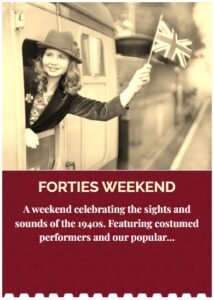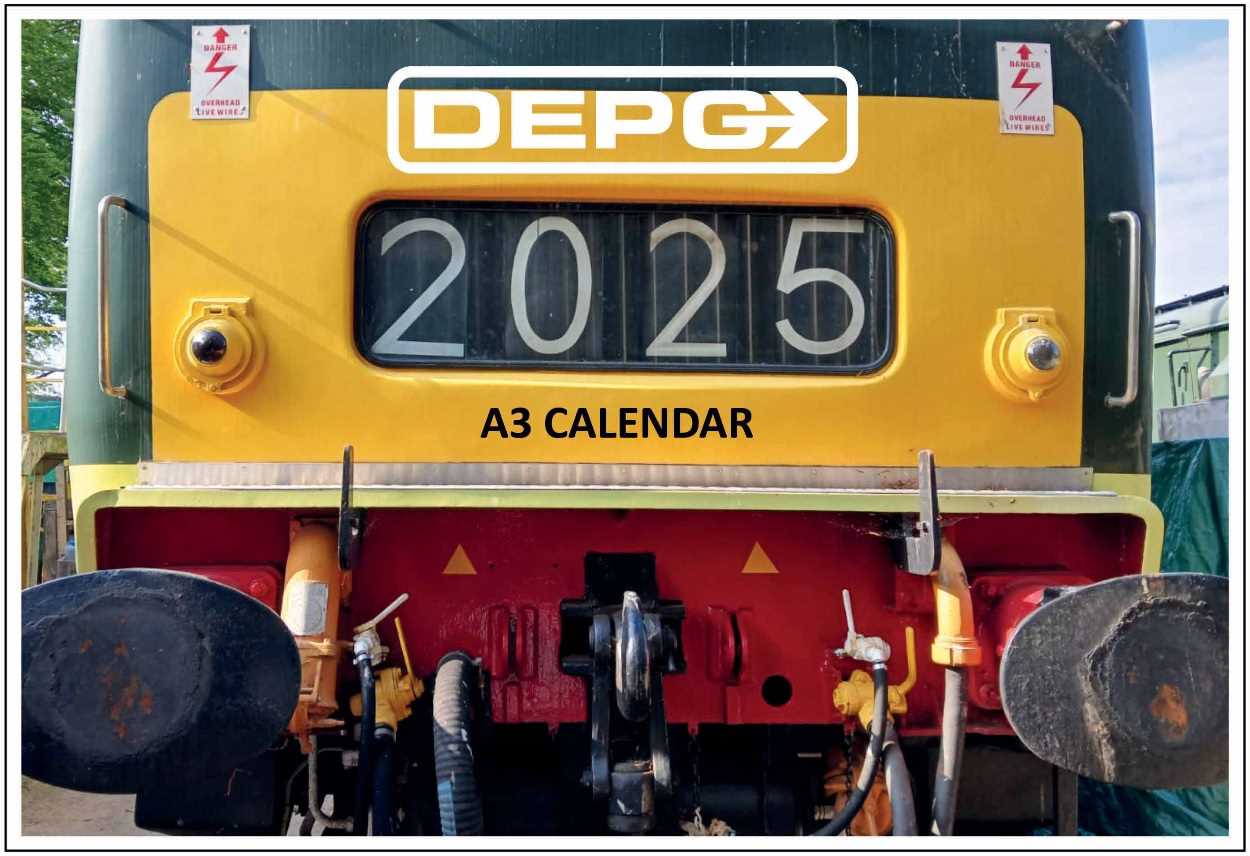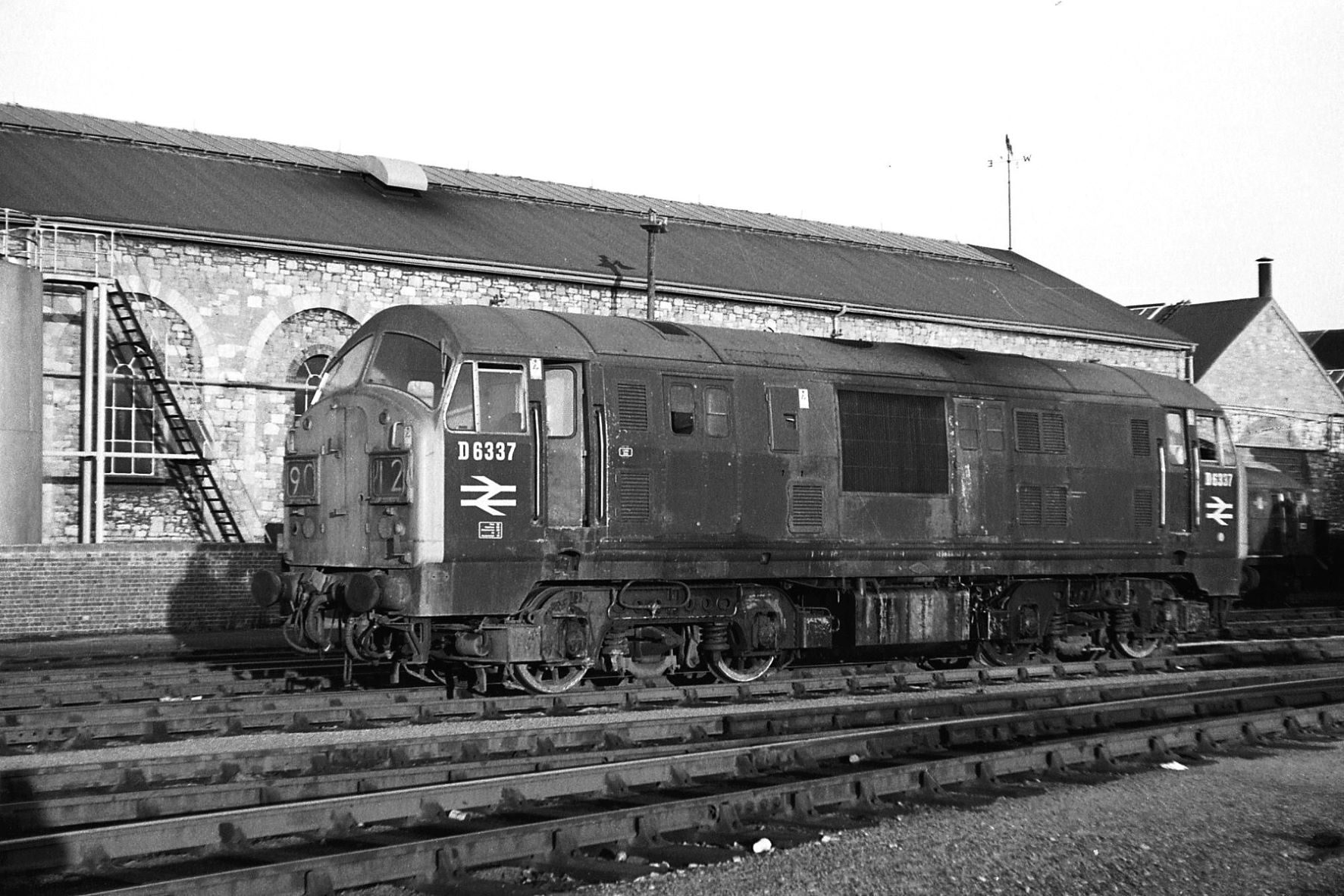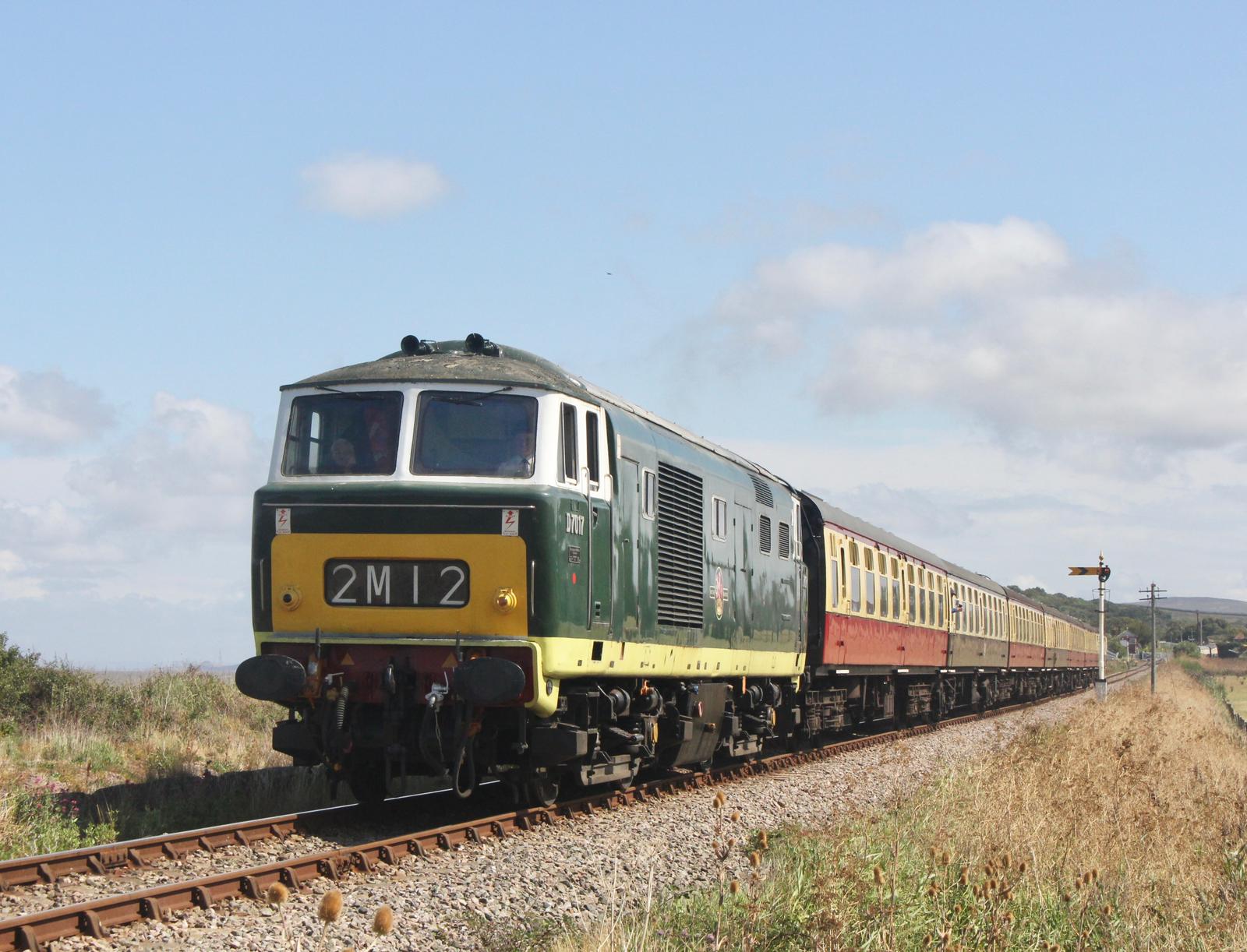
Diesels to the seaside – the classic summer scene on the West Somerset Railway. Class 35 ‘Hymek’ D7017 crosses Lower Ker Moor after departing from Blue Anchor station with seven Mark 1 coaches in tow, en route to Dunster and Minehead. Pictured on Saturday 24th August 2024 by Josh Brinsford © CC BY-NC 3.0
The early rainfall that gave us a wet and dull start to the weekend cleared by lunchtime and morphed into a wonderful summer Saturday afternoon, just right for a trip to the seaside behind Beyer Peacock ‘Hymek’ D7017 ! The loco was in fine form, making light work of the seven Mark 1 coaches that are typical of the peak summer season. The loco was in use again the following day and delivered another fine performance, marking her eighth appearance on public services this season.
The ‘Hymek’ will undergo an underframe exam and brake block adjustment at Minehead on Saturday 31st before running ‘light engine’ back to Williton where she will remain until her final rostered working of this season, the BLUE timetable diesel turns on Saturday and Sunday 21st/22nd September.
This coming weekend we will have both of our Class 33 ‘Cromptons’ in use with D6566 (33048) covering the diesel turn on Saturday, changing over to sister D6575 (33057) at Williton on the last leg of the journey back to Minehead. This loco swap is to allow D6566 to undergo some maintenance work at Williton to ensure that both locos retain their excellent record for reliability.
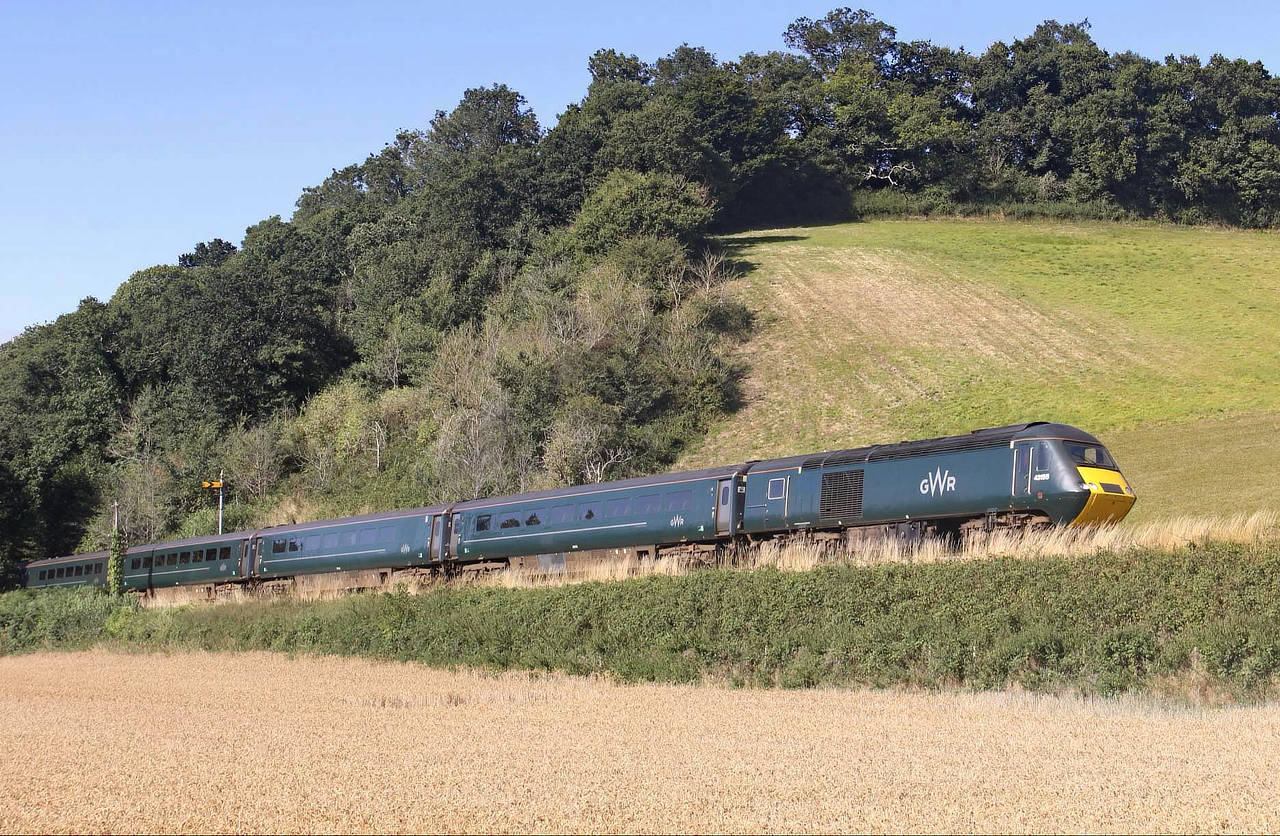
Visiting GWR ‘Castle’ Class HST (43155 leading, 43154 trailing) provided another classic WSR image when climbing past Castle Hill on the outskirts of Williton, cleanly and quietly, on her way to Bishops Lydeard. Pictured on Wednesday 14th August 2024 by Josh Brinsford © CC BY-NC 3.0
PROJECT 22 UPDATE
In March 2014, a group of like-minded people got together to set up ‘PROJECT 22‘ with the objective of building a NEW example of a class of locomotive that was not fortunate enough to be spared from the cutter’s torch – namely the NORTH BRITISH TYPE 2 DIESEL-HYDRAULIC, later to be known as Class 22. This ambitious project got off to a very good start and managed to acquire an engine of the correct type, in fact one that had previously been installed in Class 43 ‘Warship’ D850 ‘SWIFT’ !
However, the size of the task and the need for significant resources, both human and financial, proved too large for the relatively small number of enthusiasts who remembered these predominantly ‘West Country’ locos, so the lofty ideals could not be achieved. HATS OFF for trying though !

North British Type 2 Class 22 6356 was the penultimate of the 58 members of the class, entering service in September 1962. The loco was pictured at Exeter St Davids, where the type could often be seen on a wide range of duties until 1971 when the last four survivors of the class were culled. This loco only saw 9 years of service before being withdrawn as non-standard and surplus to requirements. Photo from the Project 22 collection © CC BY-NC 3.0
Here’s a statement that has been provided to the DEPG by Richard Benyon of Project 22:
“After 10 years, Project 22 has drawn to a close. The group’s aspiration to build a Class 22 failed, due to not being able to attract a management committee to take the project forward after many years of slow but steady technical design work and the collecting of components and assets which included a MAN engine number 220 last carried in a Warship. These assets have been protected should anyone come up with a plan to continue the project.
It was felt that continuing to accept donations for a project that had almost come to a halt wasn’t practical, so all members were contacted and advised that the funds raised would be used to help other heritage railway projects in the form of donations to be split between the groups that had supported P22 in many ways over the years, namely:
-
- The Western Locomotive Association
- The Diesel & Electric Preservation Group
- Bury Hydraulic Group
- The Dean Forest Railway
Over 10 years we have raised funds through donation and sales. We are very grateful to our members for many years of support and generosity and we are thankful that we can pass this generosity on to help these groups.”
Project 22
As a direct result of the above, the DEPG has received a donation of £5,795 from Project 22 which has been allocated to the D1010 Restoration Fund as requested by the donor. Although it is sad to read that Project 22 has come to an end, the funds have been distributed for the continuance of diesel-hydraulic locomotive restoration elsewhere, and the DEPG very much appreciate being included in that distribution. THANK YOU VERY MUCH, PROJECT 22 !
DIESEL RUNNING DATES
Our locos will next be in use this coming weekend 31st August and 1st September with Class 33 ‘Cromptons’ in charge, D6566 (33048) on Saturday and D6575 (33057) on Sunday, working the 10:00 departures and subsequent 80-mile diagrams from Minehead on both days.
We have added another date for Class 35 ‘Hymek’ D7017 to haul the BLUE timetable diesel turn and this loco will now work on Saturday 21st and Sunday 22nd September with 80 miles of haulage available each day.
Keep an eye on our DIESEL RUNNING DATES page for details of diesel-hauled public services and sign up to our DIESELGEN email bulletin service to get advance notice of non-public service running.
FORTHCOMING EVENTS on the WSR (click on the links below for more details):
Saturday and Sunday 14th and 15th September – The Forties event
Click here to go to our DIESEL RUNNING DATES page
Click here to go to our ONLINE SHOP
Thank you very much for your support !
LOCO NEWS:
Class 52 D1010 ‘WESTERN CAMPAIGNER’ – some excellent progress has been made on the overhaul of the first of D1010‘s bogies, with volunteers David and Sid each providing four days of constant effort, plus a major effort from Martin, James and Karl on the Saturday. The ‘B’ bogie has now completed the third stage (see below) with all six primary springs having been lifted out. The general scheme of work is as follows, with status information added:
- Remove the cardan shafts – completed on 10th August
- Remove the brake rigging – completed on 24th August
- Remove the primary springs – completed on 24th August
- Remove the equalising beams and pedestals
- Remove the secondary springs
- Inspect the bogie frames, wheel bearings and gearboxes
- Replace the torque reaction rubbers
- Re-assemble using repaired or replacement parts as required.
Volunteer D1010 team member Ian F has resumed his work on the loco bodywork, his aim being to get as much done as possible before the weather turns, and Tony has the repairs to the cooler groups in hand with one assembly close to completion and treated to a coat of gloss by Julie on Friday 23rd. There’s plenty to do as always, so please CONTACT US if you are a DEPG member and would like to come along to help.
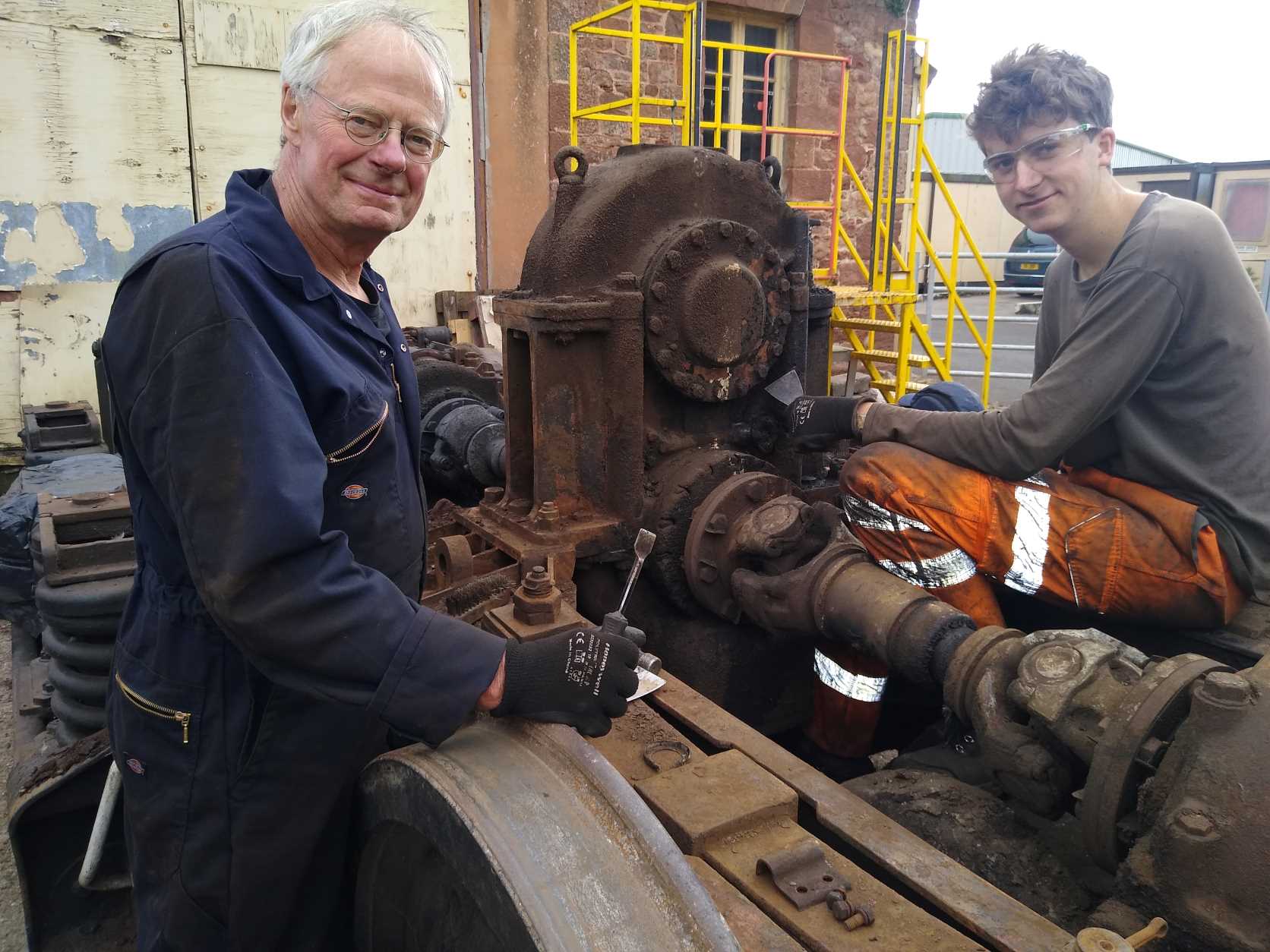
D1010 – Volunteers David and Sid took a break from dismantling the brake rigging on the ‘B’ bogie to do some therapeutic dirt scraping on the ‘A’ bogie outdoors at Williton on Wednesday 21st August 2024. Photo by Colin Foxhall © CC BY-NC 3.0
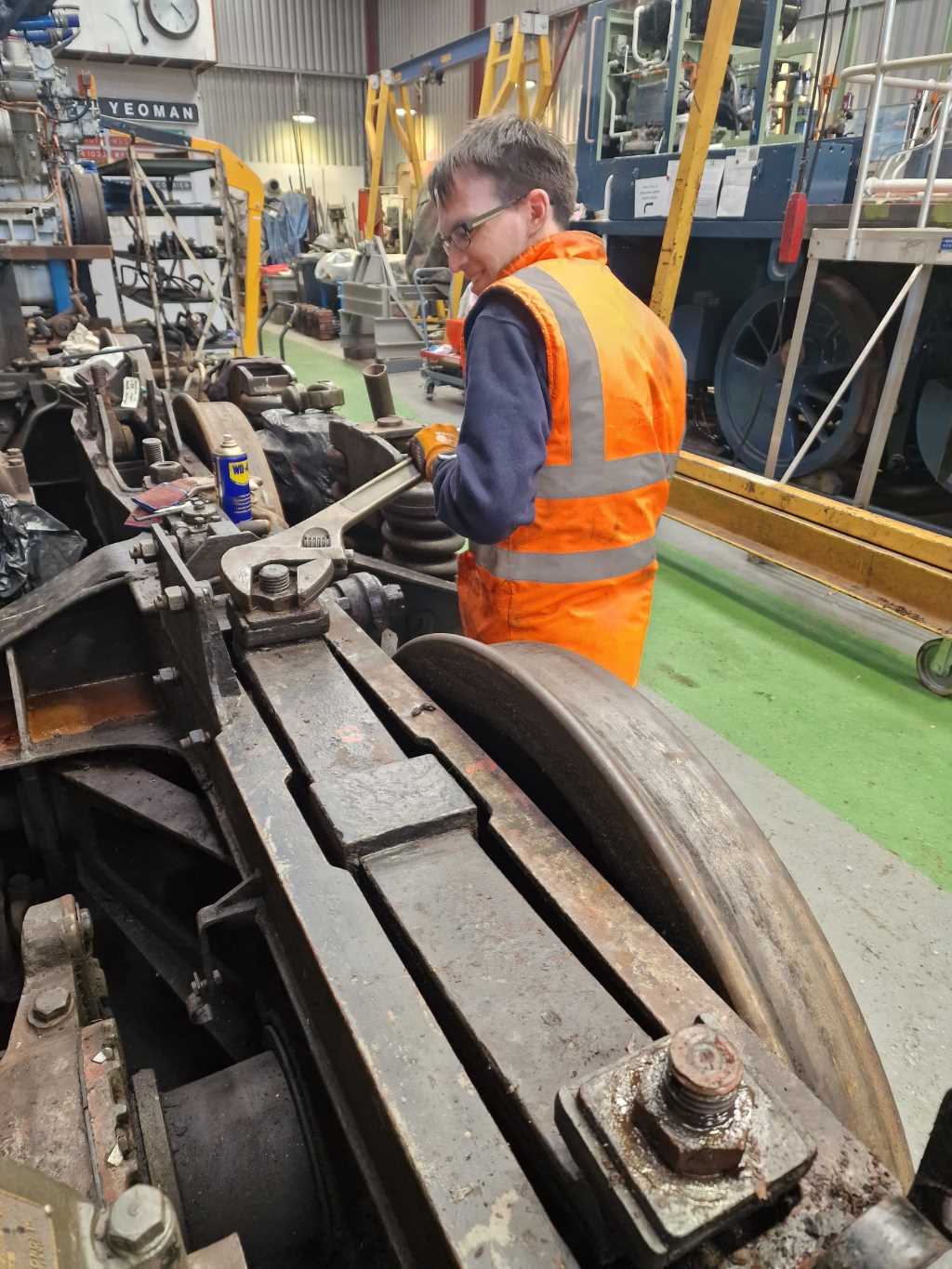
D1010 – volunteer guard and secondman James tackled the nuts on the primary suspension leaf springs that are hidden inside the bogie frame. Each of the six springs bears down directly onto an axle box. Pictured at Williton on Saturday 24th August 2024 by Martin Howard © CC BY-NC 3.0
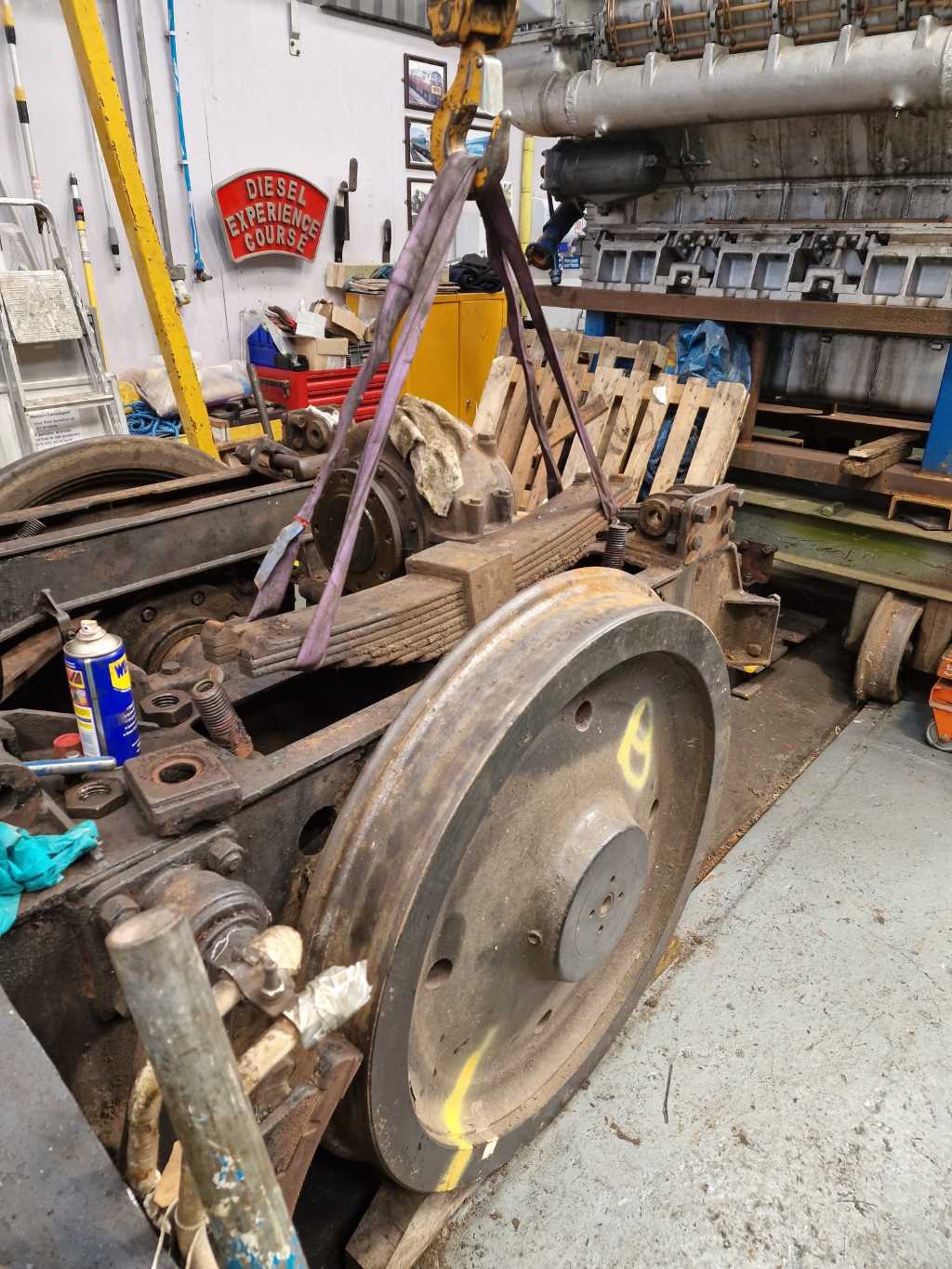
D1010 – after much effort, all six primary suspension leaf springs were lifted out from the bogie and set aside for cleaning and inspection. Pictured at Williton on Saturday 24th August 2024 by Martin Howard © CC BY-NC 3.0
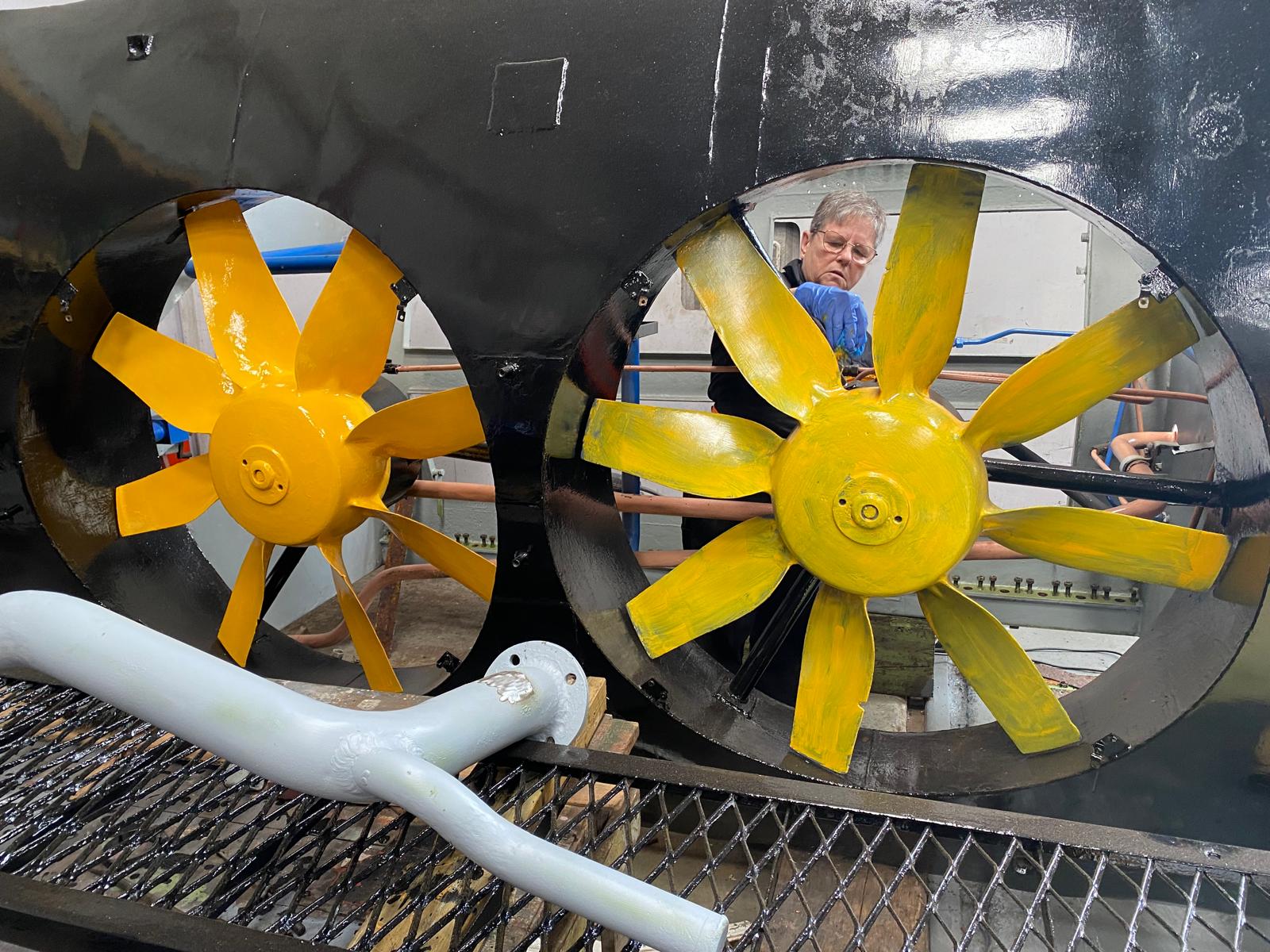
D1010 – Meanwhile, Julie applied the top coat of ‘warning yellow’ (as left) to both fans of the repaired cooler group. These massive fans ensure that sufficient airflow passes through the cooler group to dissipate the heat from the engine, the intercoolers, the engine oil heat exchanger and the transmission fluid heat exchanger. Pictured at Williton on Friday 23rd August 2024 by Paul Tucker © CC BY-NC 3.0
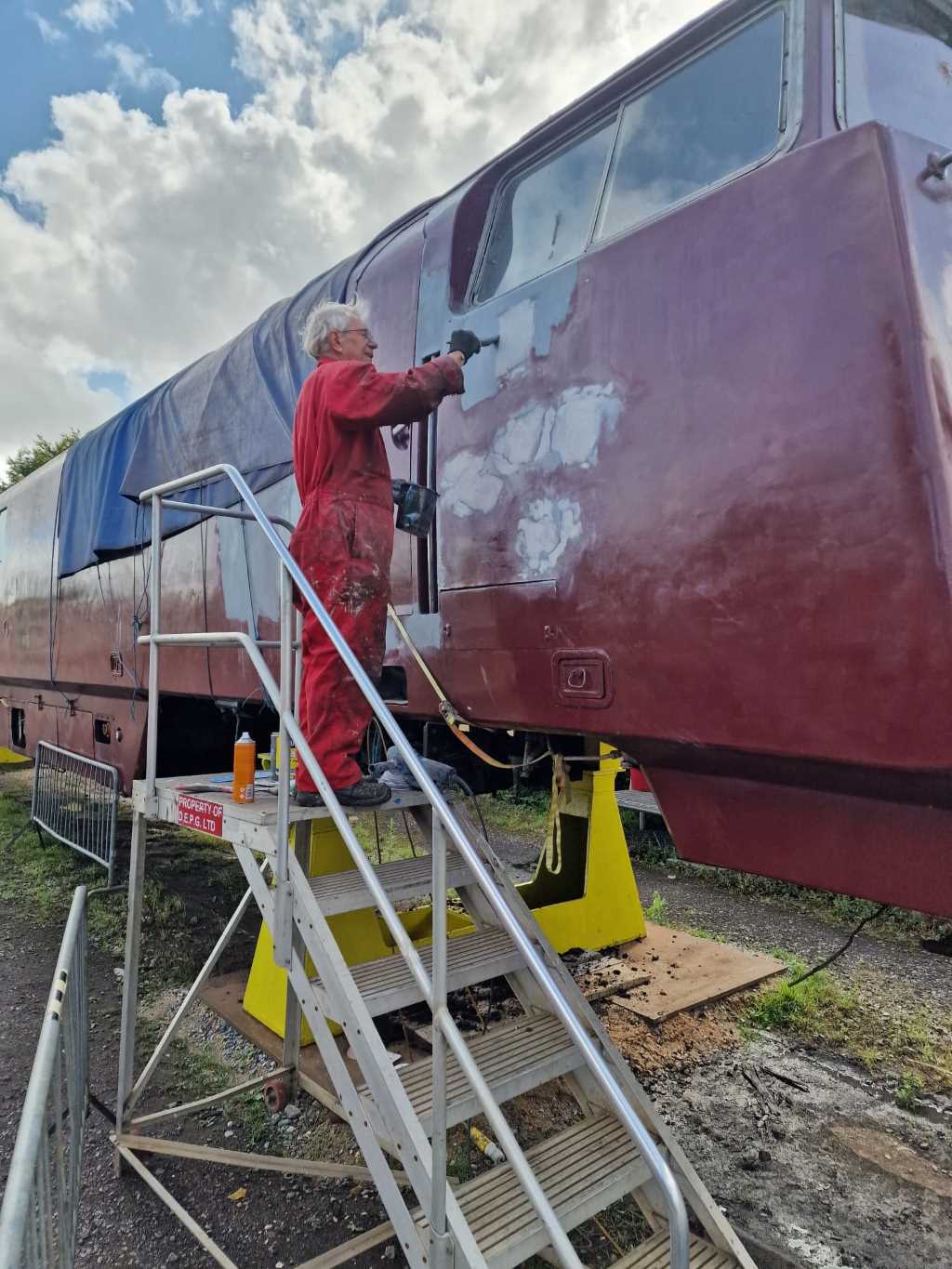
D1010 – volunteer Ian F took advantage of the good weather to get back to the massive task of preparing the bodywork of the loco for a repaint. He is working his way along every inch of the loco and we are very grateful for his commitment to the task. Pictured at Williton on Saturday 24th August 2024 by Martin Howard © CC BY-NC 3.0
Please help us with this very important work by making a donation to the D1010 Restoration Fund and support the repair work that is taking place right now. Thank you in advance for your help.
We are still offering the SPONSOR A PATCH scheme where your name or message will be engraved into the metal of the loco body as acknowledgement of your donations to the D1010 RESTORATION FUND. We are a bit behind with the engraving but now that the loco body has been determined as safe to work on, we can resume the engraving and catch up. There is plenty more metal yet to be engraved, so GET YOUR SPONSORED PATCH BY CLICKING THIS LINK !
Class 09 D4107 (09019) – this loco is based at Bishops Lydeard and is in regular use in support of WSR activities.
Class 33 D6566 (33 048) – This loco has handled the role of Duty Loco and has been outstationed at Minehead throughout August. This loco will be in use on the BLUE timetable on Saturday 31st August and will then change places with sister D6575 (33057) who will work the service on Sunday 1st September. See our DIESEL RUNNING DATES page for additional dates.

D6566 (33048) was pictured at Crowcombe Heathfield on Sunday 18th August 2024 while working the last service of the day from Bishops Lydeard to Minehead. Photo by Tom Courtney © CC BY-NC 3.0
Class 33 D6575 (33 057) – this loco is Williton and is just awaiting the attention of the cleaning gang before returning to service. She will be changing places with her slightly older sister during the station stop at Williton, just after 5pm on Saturday 31st August.
Class 35 ‘Hymek’ D7017 – as covered previously, this loco will be returning to Williton on Saturday 31st August to be made ready for her next booked duties, which will be on Saturday 21st and Sunday 22nd September.
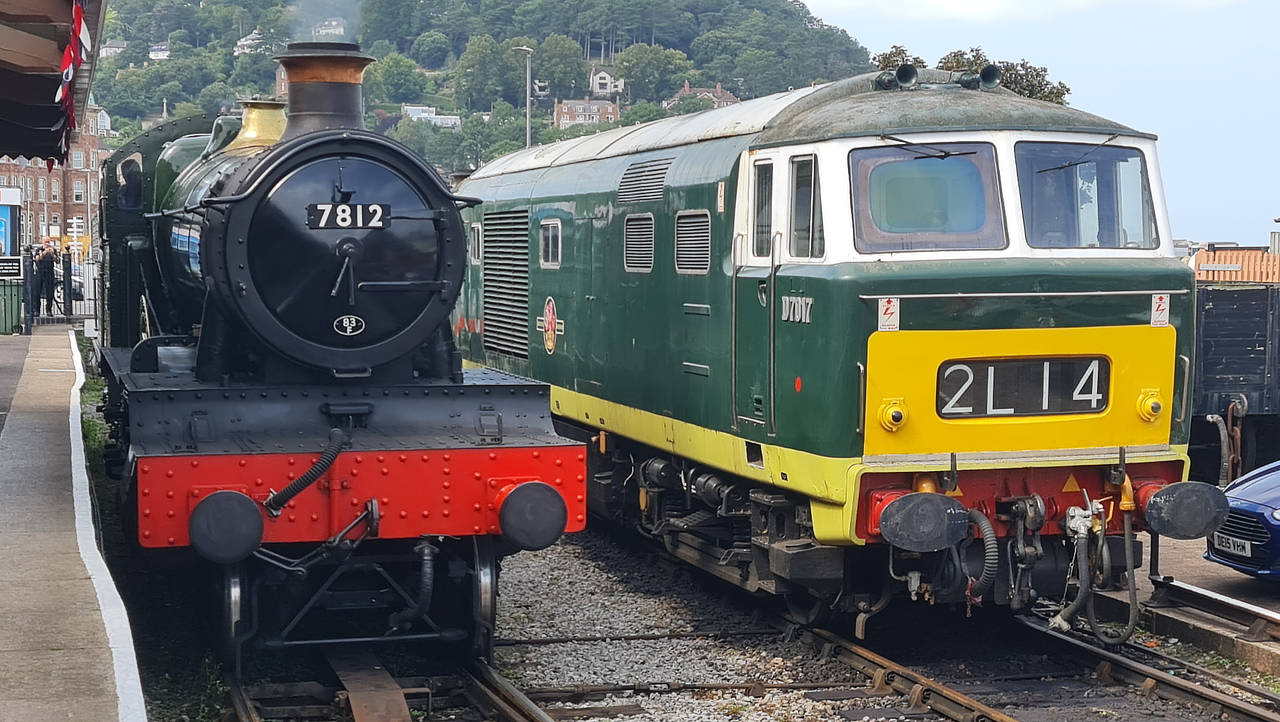
GWR 4-6-0 7812 ‘ERLESTOKE MANOR’ was pictured in the headshunt, alongside Class 35 ‘Hymek’ D7017 at Minehead on Bank Holiday Monday 26th August 2024. Photo by Mark Ireland © CC BY-NC 3.0
Class 35 ‘Hymek’ D7018 – the careful work of re-assembly of the transmission continued, with the primary and secondary gear shaft assemblies being trial-fitted into the housing to check for the required dimensions and clearances. This work is laborious but is essential to ensuring that the transmission functions as intended, so it is time well spent. So far so good !
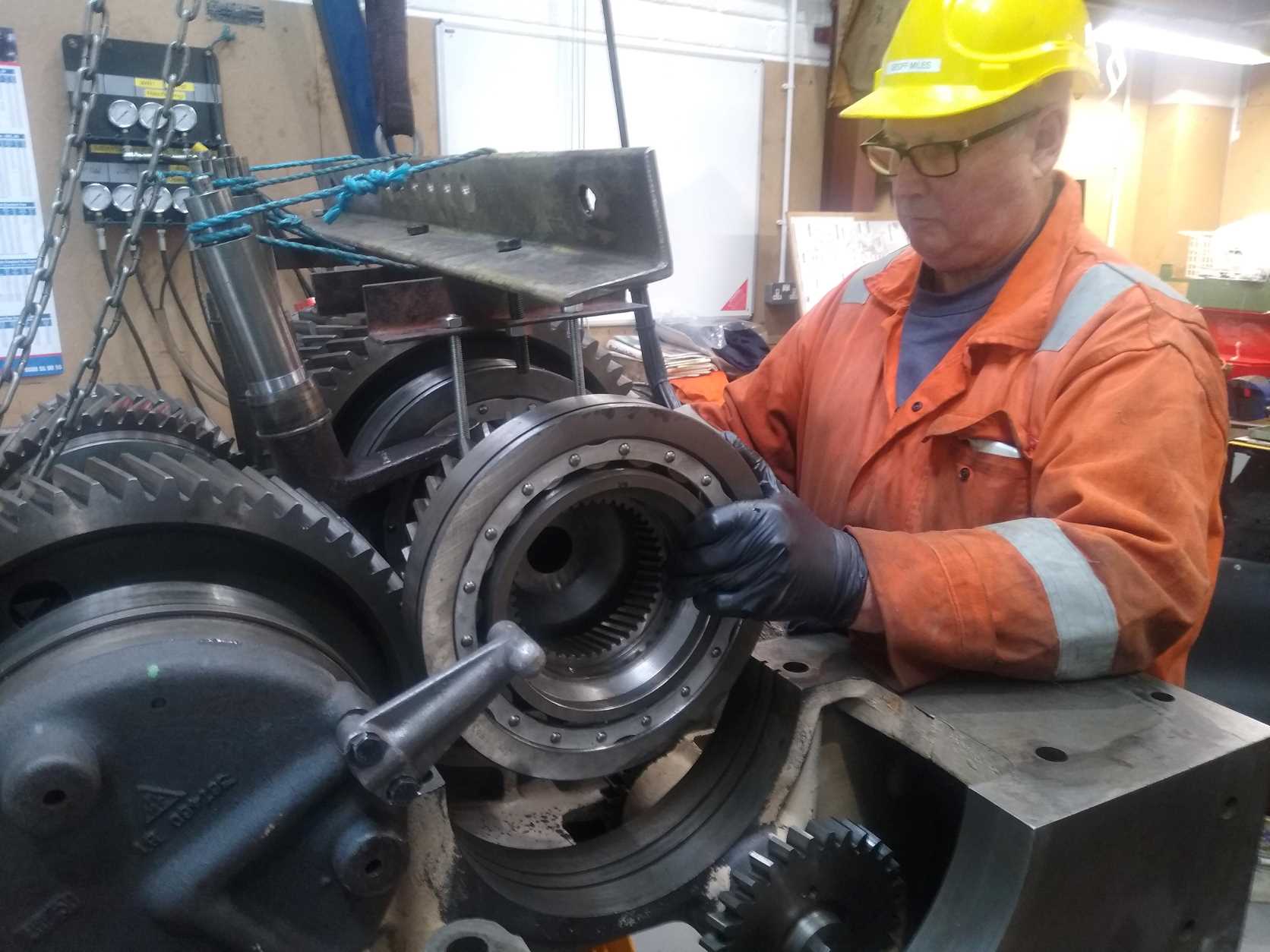
D7018 – the primary gear shaft assembly was lowered into the housing under the careful guidance of Geoff at Williton on Monday 19th August 2024. The helical teeth inside the shaft will engage with the output shaft from the torque converter at a later stage. Photo by Colin Foxhall © CC BY-NC 3.0
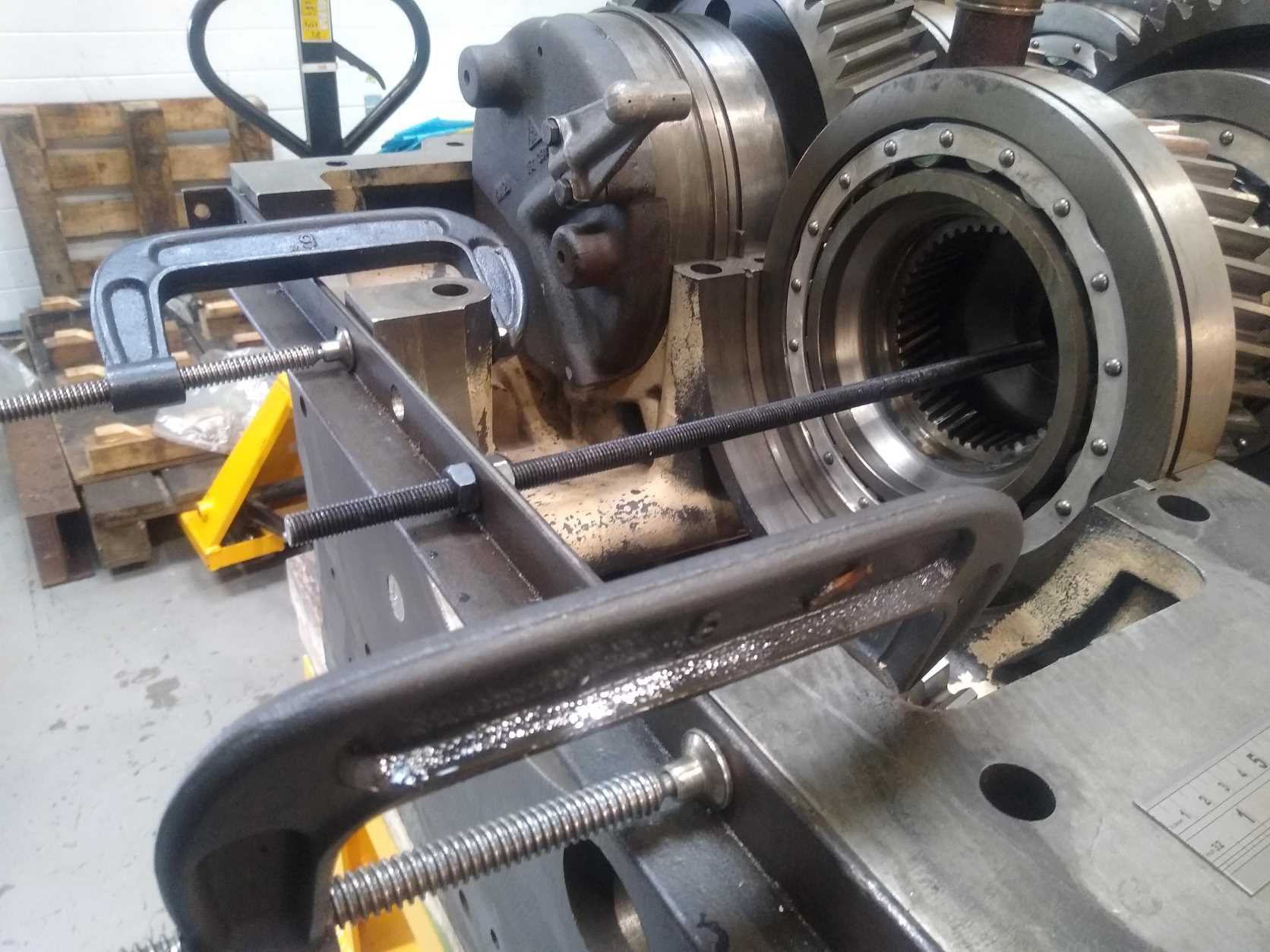
D7018 – a device was then made to set the required axial position of the primary gear shaft assembly so that the various clearances and tolerances could be measured along the length of the shaft. This is essential to ensure that everything will operate as it should when the rest of the assembly is added (by which time the opportunity to measure and adjust will have disappeared). Pictured at Williton on Monday 19th August 2024 by Colin Foxhall © CC BY-NC 3.0
Please help us with this very important work by making a donation to DEPG funds and allowing us to support the repair work that is taking place on D7018 right now. Thank you in advance for your help.
Class 14 ‘Teddy Bear’ D9518 – the major progress this week was with the engine overhaul, with the ‘turnover rig’ allowing relatively easy access to the camshaft that sits in the root of the V-shape between the two banks of cylinders. The camshaft was in good condition, the easily replaceable white metal bearing shells having sacrificed themselves to keep the camshaft rotating freely. The cylinder heads and valves are undergoing cleaning and re-profiling to ensure that the performance of the overhauled engine meets expectations.
Meanwhile, work done offsite by Colin G demonstrates both the degree of progress and the attention to detail, with the refurbishment of the driver’s controller/reverser handle assemblies now looking like they just came from the production line at the Brush Engineering factory, and almost ready to be re-installed and wired up by John. Well done team !
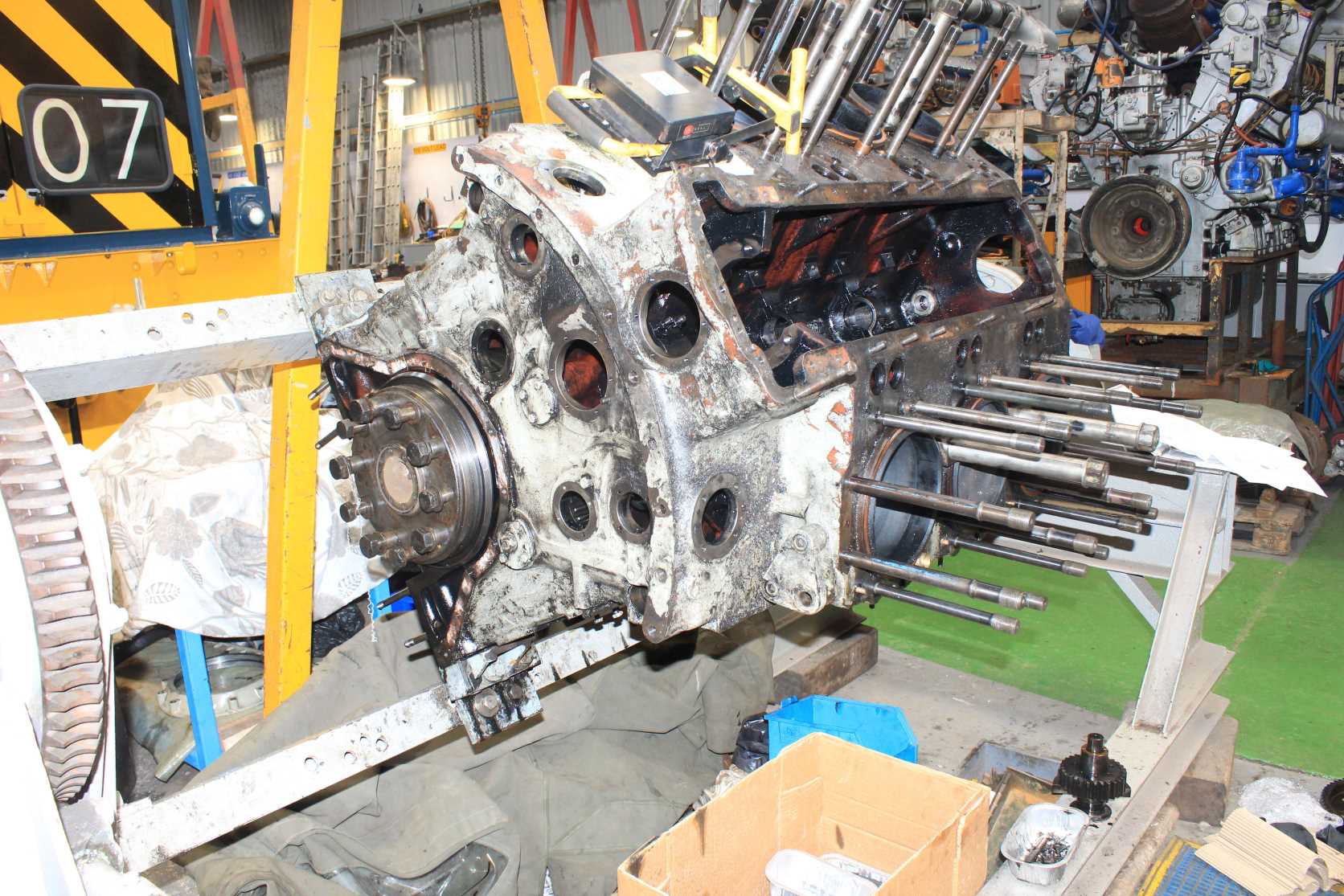
D9518 – the cylinder block of the Paxman ‘Ventura’ 6YJXL engine was rotated using the ‘turnover rig’ to allow access to the camshaft in the centre Vee space at Williton on Tuesday 20th August 2024. Photo by Terry Deacon © CC BY-NC 3.0

D9518 – the camshaft is mounted in the centre Vee space of the engine and runs in three plain bearings with a bushing at the free end. Pictured at Williton on Tuesday 20th August 2024 by Terry Deacon © CC BY-NC 3.0

D9518 – the 12-lobe camshaft is driven by the helical gear on the left of the shaft, which in turn meshes with the timing gear that is driven from the crankshaft. Pictured at Williton on Tuesday 20th August 2024 by Terry Deacon © CC BY-NC 3.0
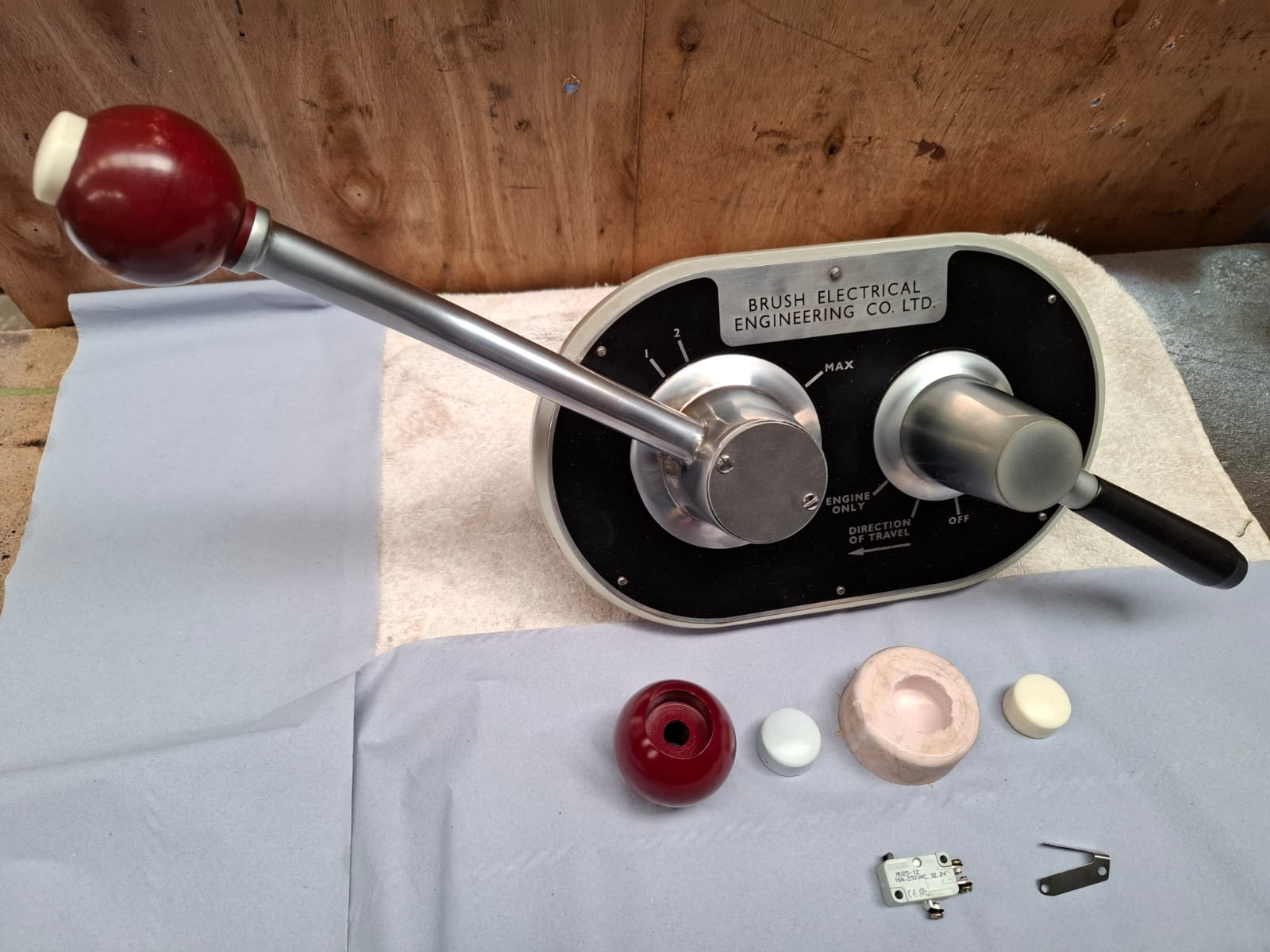
D9518 – one of the two refurbished controller/reverser units, complete with new parts for the Driver’s Safety Device (DSD) which comprises the white button at the end of the handle plus internal rods, springs and a microswitch that resets the DSD (power is cut and the brakes applied automatically if the DSD button is not held down). Detailed restoration work and photo dated 24th August 2024 by Colin Girle © CC BY-NC 3.0
THANK YOU VERY MUCH TO OUR VOLUNTEERS AND ALL WHO HAVE FINANCED THE WORK ON D9518 !
Click here or on the image below to make a donation towards the restoration of D9518. Thank you very much for your support !
Class 14 ‘Teddy Bear’ D9526 – this loco is stabled at Williton and is waiting for her next job, which will hopefully be in September … (news will be posted on DIESEL RUNNING DATES and DIESELGEN pages).
Class 47 47077 ‘NORTH STAR’ – this loco is based at Grosmont on the North Yorkshire Moors Railway but is currently out of service because of a coolant leak from the liner of cylinder B3. Only one of the 12 cylinders appears to be affected, but further investigations will be carried out as part of the repair work. We hope to have reached agreement with the subcontractor and the NYMR during the next week or so, with the aim of getting the repair work completed by early October.
Andrew Barclay 0-4-0DH 578 – this loco is currently inside the loco shed on No. 2 road and remains fully serviceable and available for yard pilot duties.
BOOK REVIEW: with the closedown news from PROJECT 22 reported earlier, it is quite opportune that we have both volumes of Anthony Sayer’s detailed analysis of the Class 22s in stock and ready for those who want to learn more about these extinct machines. Even though they were far from the top of the loco spotter’s list of favourites, they still have a right to exist and it is sad that not a single example of Classes 16, 21, 22, 29, 41 or 43 remain, a total of 164 main line locomotives that were built in Glasgow for BR by the North British Locomotive Company.
To find out more, consider purchasing VOLUMES 1 and 2 of THE NORTH BRITISH CLASS 22 by Anthony P. Sayer.
VOLUME 1 – Setting the Scene VOLUME 2 – Detailed Insights
Volume 1 tells the story of the origins and development of the NBL Class 22 locos, and covers each member of the class in some detail, in the usual style of the author. Volume 2 delves into their service record and extensive modifications list, ending with details on their final disposal. None were saved.
Highly recommended and offered at £26 per copy via the DEPG online store. Click here or on the image above to get your copy and in doing so, support the DEPG !
The DEPG 2025 CALENDAR is now available for mailing, comprising 14 printed pages of A3 (twice A4 size) glossy paper on a spiral wire binder. This calendar features the DEPG’s locomotives, both in service and in preservation, with all of the photos being provided by members and supporters. Click here or on the image above to GET YOUR COPY – WHILE STOCKS LAST – for £14 plus p&p.
ON SHED: staying with the Class 22 theme of this roundup, we would welcome any photos of the Class that our readers could share, because our own archive is quite lacking in respect of the type. We do have this photo from regular contributor Barry Gay, and we first featured this photo in January 2022, but hopefully readers from those early days will excuse a repeat of this highly relevant capture. Many thanks to Barry for sharing his photo with us all.
North British Locomotive Company Type 2 diesel-hydraulic Class 22 number D6337 stands at Newton Abbot loco shed after being refuelled on the evening of 5th July 1971. This loco entered service at Newton Abbot on 13th March 1962 and was withdrawn on 21st October 1971 after a short operational life of less than 10 years. The loco was broken up at Swindon Works in May of 1972. Photo by Barry Gay © CC BY-NC 3.0
DEPG NEWS: the ANNUAL GENERAL MEETING (AGM) of the DEPG has been scheduled for Saturday 7th September, to take place at Williton Depot, starting at 1400. Formal AGM notices have been sent to all members according to their communication preferences (paper, paperless except newsletter or fully paperless). Please make a note of this date and please do come along to help, support and guide the DEPG for the long-term benefit of our heritage locos and associated artefact collection.
Only fully paid-up members will be able to vote, so please make sure that you keep your membership account up to date ! Thanks !
A Board Meeting will be held at Williton on Saturday 31st August, so please let us know by using our CONTACT FORM if you are a member and have any questions that you would like to place before the board.
The DEPG is a charity and is run entirely by volunteers, many of whom give both their time and their money to the continuance of work on the locos in the DEPG fleet. If you have been enjoying the roundup for free, have you considered joining us for just £1 a month ? You can then add your name to all of those helping out on the above projects and play your part in the future of our locos for a lot less than the price of a cup of coffee!
JOIN US using whichever membership class is appropriate for your situation and means. CLICK HERE or on the image below or use the QR code to get the details.
If you would like to go one step further and come along to help with the work on the locos in our fleet, then please use our CONTACT FORM to let us know that you would like to volunteer and we will respond with more details.
We look forward to hearing from you !

